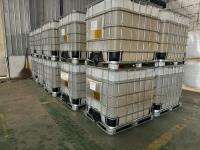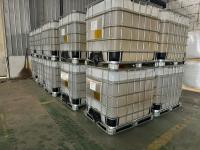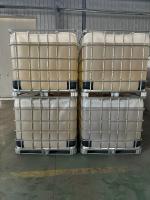Our Products
Product Center / magnafloc LT-7989 polyamine equiavlent model can be replaced by Chinafloc

Polyamines are a class of cationic, water-soluble polymers that have become indispensable in water treatment, mineral processing, and industrial wastewater clarification. Among the most well-known commercial formulations is Magnafloc LT-7989, a liquid polyamine flocculant developed for high-performance solid–liquid separation processes. This specialty chemical is widely used in municipal wastewater treatment plants, industrial effluent systems, and mineral beneficiation circuits. Its effectiveness stems from its strong cationic charge, high reactivity with suspended solids, and ability to improve settling, clarification, and filtration efficiency.
1. Nature of Polyamine Flocculants
Polyamines are synthesized polymers that carry a high density of positively charged amine groups along their backbone. These cationic sites readily interact with the negatively charged surfaces of suspended particles, colloids, and organic matter commonly found in wastewater and mineral slurries. Through mechanisms such as charge neutralization and bridging flocculation, polyamines destabilize suspensions and promote the formation of larger, denser flocs that settle quickly.
Magnafloc LT-7989 is a proprietary liquid polyamine formulation supplied at a controlled viscosity and concentration. Compared with dry polyacrylamides, it offers easier handling, faster dissolution, and excellent compatibility with continuous dosing systems in treatment plants.
2. Primary Application: Water Clarification
The central application of Magnafloc LT-7989 is in clarifying water and wastewater streams. By binding to colloidal solids, natural organic matter, oils, and other impurities, the polymer allows suspended matter to agglomerate into larger particles that can be removed through sedimentation, flotation, or filtration.
Key clarification uses include:
-
Municipal Drinking Water Treatment: Enhancing the removal of turbidity, algae, and natural organics prior to disinfection.
-
Industrial Process Water: Improving clarity of intake water for cooling systems, boilers, or food and beverage manufacturing.
-
Effluent Polishing: Producing high-quality treated effluent suitable for discharge or reuse.
Because it is highly cationic, Magnafloc LT-7989 is particularly effective in low-turbidity waters where other flocculants, such as anionic polyacrylamides, may be less efficient.
3. Application in Sludge Dewatering
Another major application area of Magnafloc LT-7989 is sludge thickening and dewatering. Wastewater treatment processes inevitably generate biological and chemical sludges that require volume reduction before disposal. These sludges typically carry a negative charge and contain significant amounts of bound water.
When Magnafloc LT-7989 is applied:
-
The polymer neutralizes surface charges, reducing repulsive forces between particles.
-
Sludge solids aggregate into larger, more porous flocs.
-
Water is released more easily, improving drainage during centrifugation, belt pressing, or filter pressing.
The result is lower sludge moisture content, reduced disposal volume, and substantial cost savings in transport and landfill operations.
4. Application in Mining and Mineral Processing
Polyamine flocculants such as Magnafloc LT-7989 are also widely used in mineral beneficiation and tailings treatment. In mining circuits, water clarity and thickening efficiency are vital for both product recovery and environmental protection.
Examples of uses include:
-
Coal Preparation Plants: Improving thickener performance, clarifying recycled water, and conditioning fine coal tailings.
-
Bauxite and Alumina Refining: Enhancing red mud settling and washer performance when used alongside anionic flocculants.
-
Iron Ore and Base Metals: Assisting in thickening and clarification processes, producing clearer overflow for reuse in flotation or grinding.
In these settings, Magnafloc LT-7989 is often applied in combination with anionic polyacrylamides. The cationic polyamine neutralizes surface charges, while the anionic polymer provides bridging, resulting in faster settling and denser underflows.
5. Role in Oil and Gas Wastewater
The oil and gas sector generates complex wastewaters containing emulsified oils, grease, and fine solids. The strong cationic charge of Magnafloc LT-7989 makes it highly effective in breaking oil-in-water emulsions and clarifying produced water streams. By destabilizing emulsified droplets, the polymer facilitates coalescence and separation, producing cleaner water for reinjection or discharge and concentrated oil phases for recovery or disposal.
6. Compatibility and Use with Other Chemicals
In many treatment systems, polyamines like Magnafloc LT-7989 are used in combination with other treatment chemicals such as inorganic coagulants (aluminum sulfate, ferric chloride), anionic flocculants, or specialty reagents. When applied as a primary coagulant, the polyamine reduces the dosage of metal salts required, lowering sludge generation and disposal costs. When used as a co-flocculant, it enhances the performance of anionic polyacrylamides, creating stronger flocs that withstand shear in pumps and mixers.
7. Benefits and Advantages
The application of Magnafloc LT-7989 provides numerous operational, economic, and environmental benefits:
-
High Efficiency in Charge Neutralization: Strongly cationic, enabling rapid destabilization of negatively charged suspensions.
-
Faster Settling and Clarification: Produces clearer effluents and reduces turbidity to very low levels.
-
Improved Sludge Dewatering: Lowers moisture content, reducing handling and disposal costs.
-
Versatility: Effective across municipal, industrial, mining, and oilfield sectors.
-
Reduced Chemical Usage: Minimizes the need for inorganic coagulants, decreasing sludge volume.
-
Operational Reliability: Provides stable, predictable performance even with variable wastewater quality.
-
Environmental Compliance: Assists facilities in meeting increasingly stringent discharge standards.
8. Environmental and Sustainability Considerations
Modern industries place strong emphasis on sustainability, and Magnafloc LT-7989 contributes significantly in this regard. By improving water clarity and enabling reuse, it reduces freshwater demand. By lowering sludge volumes, it decreases the environmental footprint of waste disposal. Furthermore, replacing part of traditional inorganic coagulant demand with polyamine reduces the generation of chemically bound sludge, aligning treatment processes with circular economy principles.
9. Economic Perspective
From an economic standpoint, the adoption of Magnafloc LT-7989 often results in lower total cost of treatment. Savings are realized through:
-
Reduced sludge hauling and disposal costs.
-
Lower coagulant consumption.
-
Improved process throughput in thickeners and clarifiers.
-
Reduced downtime and maintenance due to scaling and fouling.
These factors, combined with the polymer’s versatility, make it a cost-effective solution in competitive industrial environments.



426_small.jpg)

